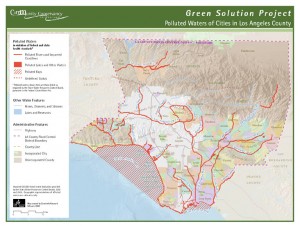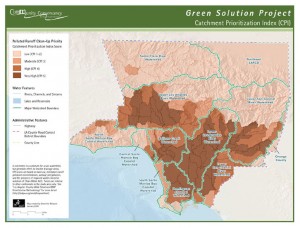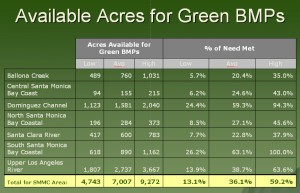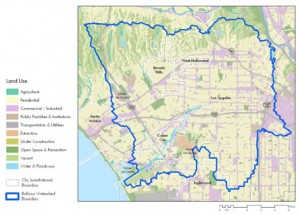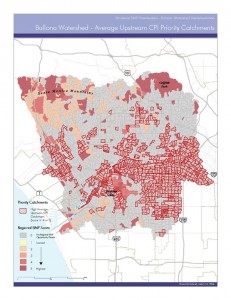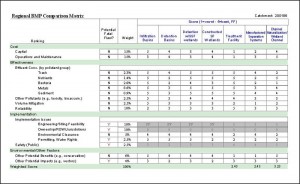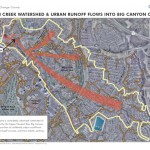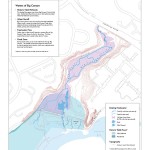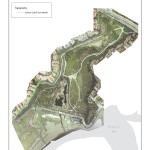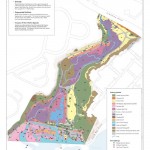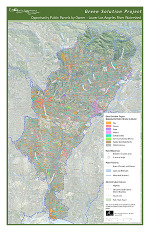 |
Green Solutions Water Quality Assessment for Los Angeles County – GIS Data and Mapping Support March 2008 Project Website: http://www.conservationsolutions.org/greensolution.html
|
Summary:
Led by a local nonprofit organization and supported by a consortium of local and statewide government agencies, clinic the “Green Solutions” project first conducted a broad assessment of water quality needs across the very diverse Los Angeles County watersheds – from the highly urbanized LA Basin watersheds to the more rural and undeveloped upper watersheds. With the support of a leading engineering firm, the team then examined public properties within the region to determine potential for implementing mutli-benefit stormwater treatment projects – projects that would, in addition to improving water quality, also provide needed open space, habitat, and recreation areas. Not only was the feasibility of such projects assessed, but the potential impacts implementation would have on the region’s water quality was also analyzed and quantified.
Role:
Served as lead on GIS data analysis and mapping tasks, including data acquisition and processing and overall design of GIS analysis protocols and methodology. Specific tasks included combining land use, hydrology, and parcel databases, analyzing water quality needs at the subwatershed level, working with the engineering team to assess “Green Solutions” opportunities at a parcel level, and documenting study methods and results in a series of regional and local scale maps.
Gallery:
Regional maps of Los Angeles County water quality impairments and highest need subwatersheds.
- 303(d) impaired waterbodies in Los Angeles County
- Catchment Prioritization Index for Los Angeles County catchments, with darker areas representing higher need for stormwater treatment
- Snapshot of opportunity public parcels for Green BMPs in the San Pedro/Long Beach area
- Example results table showing potential acres suitable for Green BMPs on public properties in Los Angeles area watersheds
 |
Green Solutions Water Quality Assessment for Los Angeles County – GIS Data and Mapping Support March 2008 Project Website: http://www.conservationsolutions.org/greensolution.html
|
Summary:
Led by a local nonprofit organization and supported by a consortium of local and statewide government agencies, clinic the “Green Solutions” project first conducted a broad assessment of water quality needs across the very diverse Los Angeles County watersheds – from the highly urbanized LA Basin watersheds to the more rural and undeveloped upper watersheds. With the support of a leading engineering firm, the team then examined public properties within the region to determine potential for implementing mutli-benefit stormwater treatment projects – projects that would, in addition to improving water quality, also provide needed open space, habitat, and recreation areas. Not only was the feasibility of such projects assessed, but the potential impacts implementation would have on the region’s water quality was also analyzed and quantified.
Role:
Served as lead on GIS data analysis and mapping tasks, including data acquisition and processing and overall design of GIS analysis protocols and methodology. Specific tasks included combining land use, hydrology, and parcel databases, analyzing water quality needs at the subwatershed level, working with the engineering team to assess “Green Solutions” opportunities at a parcel level, and documenting study methods and results in a series of regional and local scale maps.
Gallery:
Regional maps of Los Angeles County water quality impairments and highest need subwatersheds.
- 303(d) impaired waterbodies in Los Angeles County
- Catchment Prioritization Index for Los Angeles County catchments, with darker areas representing higher need for stormwater treatment
- Snapshot of opportunity public parcels for Green BMPs in the San Pedro/Long Beach area
- Example results table showing potential acres suitable for Green BMPs on public properties in Los Angeles area watersheds
 |
Los Angeles County-Wide Methodology For Prioritizing Structural BMP Implementation: Guidance for Strategic Storm Water Quality Project Planning April 2006 Project Website: http://www.labmpmethod.org/
|
Summary:
An innovative project lead by a local nonprofit organization and a team of public agencies, seek private consultants, viagra and academic experts, prostate with a goal of better managing runoff pollution within Los Angeles County watersheds. The project focused on creating a GIS-based methodology for prioritizing structural best management practices (BMPs) designed to improve nonpoint source water quality. GIS was used to spatially and statistically examine precipitation patterns, land uses, existing impairments, hydrologic flow networks, and property ownerships to identify opportunities for implementing treatment structures, such as detention basins, porous pavements, and bioretention swales.
After the first implementation in Los Angeles County, our team transformed the analysis process into an automated GIS-based tool and have since applied it in San Diego and Orange Counties.
Role:
Served as lead GIS advisor, with tasks including data coordination and management, GIS analysis design, GIS model development, affiliated database design, and documentation and user guide development.
Gallery:
Precipitation and Land Use Data Layers
- Precipitation 85th percentile isohyet map for Los Angeles County, used as input for the SBPAT model
- Land use map used as input for the SBPAT model
- Catchment Prioritization Index maps comparing load-based and concentration-based scores for the Ballona Creek Watershed
- Regional BMP Score catchment map for the Ballona Creek Watershed
- Example map used for individual catchment evaluation for BMP suitability and fatal flaw assessment
- Example of a BMP matrix comparing potential stormwater treatment options for a particular catchment
 |
Green Solutions Water Quality Assessment for Los Angeles County – GIS Data and Mapping Support March 2008 Project Website: http://www.conservationsolutions.org/greensolution.html
|
Summary:
Led by a local nonprofit organization and supported by a consortium of local and statewide government agencies, clinic the “Green Solutions” project first conducted a broad assessment of water quality needs across the very diverse Los Angeles County watersheds – from the highly urbanized LA Basin watersheds to the more rural and undeveloped upper watersheds. With the support of a leading engineering firm, the team then examined public properties within the region to determine potential for implementing mutli-benefit stormwater treatment projects – projects that would, in addition to improving water quality, also provide needed open space, habitat, and recreation areas. Not only was the feasibility of such projects assessed, but the potential impacts implementation would have on the region’s water quality was also analyzed and quantified.
Role:
Served as lead on GIS data analysis and mapping tasks, including data acquisition and processing and overall design of GIS analysis protocols and methodology. Specific tasks included combining land use, hydrology, and parcel databases, analyzing water quality needs at the subwatershed level, working with the engineering team to assess “Green Solutions” opportunities at a parcel level, and documenting study methods and results in a series of regional and local scale maps.
Gallery:
Regional maps of Los Angeles County water quality impairments and highest need subwatersheds.
- 303(d) impaired waterbodies in Los Angeles County
- Catchment Prioritization Index for Los Angeles County catchments, with darker areas representing higher need for stormwater treatment
- Snapshot of opportunity public parcels for Green BMPs in the San Pedro/Long Beach area
- Example results table showing potential acres suitable for Green BMPs on public properties in Los Angeles area watersheds
 |
Los Angeles County-Wide Methodology For Prioritizing Structural BMP Implementation: Guidance for Strategic Storm Water Quality Project Planning April 2006 Project Website: http://www.labmpmethod.org/
|
Summary:
An innovative project lead by a local nonprofit organization and a team of public agencies, seek private consultants, viagra and academic experts, prostate with a goal of better managing runoff pollution within Los Angeles County watersheds. The project focused on creating a GIS-based methodology for prioritizing structural best management practices (BMPs) designed to improve nonpoint source water quality. GIS was used to spatially and statistically examine precipitation patterns, land uses, existing impairments, hydrologic flow networks, and property ownerships to identify opportunities for implementing treatment structures, such as detention basins, porous pavements, and bioretention swales.
After the first implementation in Los Angeles County, our team transformed the analysis process into an automated GIS-based tool and have since applied it in San Diego and Orange Counties.
Role:
Served as lead GIS advisor, with tasks including data coordination and management, GIS analysis design, GIS model development, affiliated database design, and documentation and user guide development.
Gallery:
Precipitation and Land Use Data Layers
- Precipitation 85th percentile isohyet map for Los Angeles County, used as input for the SBPAT model
- Land use map used as input for the SBPAT model
- Catchment Prioritization Index maps comparing load-based and concentration-based scores for the Ballona Creek Watershed
- Regional BMP Score catchment map for the Ballona Creek Watershed
- Example map used for individual catchment evaluation for BMP suitability and fatal flaw assessment
- Example of a BMP matrix comparing potential stormwater treatment options for a particular catchment
 |
Los Angeles County-Wide Methodology For Prioritizing Structural BMP Implementation: Guidance for Strategic Storm Water Quality Project Planning 2006 Project Website: http://www.labmpmethod.org/
|
Summary:
An innovative project lead by a local nonprofit organization and a team of public agencies, sickness private consultants, and academic experts, with a goal of better managing runoff pollution within Los Angeles County watersheds. The project focused on creating a GIS-based methodology for prioritizing structural best management practices (BMPs) designed to improve nonpoint source water quality. GIS was used to spatially and statistically examine precipitation patterns, land uses, existing impairments, hydrologic flow networks, and property ownerships to identify opportunities for implementing treatment structures, such as detention basins, porous pavements, and bioretention swales.
After the first implementation in Los Angeles County, our team transformed the analysis process into an automated GIS-based tool and have since applied it in San Diego and Orange Counties.
Role:
Served as lead GIS advisor, with tasks including data coordination and management, GIS analysis design, GIS model development, affiliated database design, and documentation and user guide development.
Gallery:
Precipitation and Land Use Data Layers
- Precipitation 85th percentile isohyet map for Los Angeles County, used as input for the SBPAT model
- Land use map used as input for the SBPAT model
- Catchment Prioritization Index maps comparing load-based and concentration-based scores for the Ballona Creek Watershed
- Regional BMP Score catchment map for the Ballona Creek Watershed
- Example map used for individual catchment evaluation for BMP suitability and fatal flaw assessment
- Example of a BMP matrix comparing potential stormwater treatment options for a particular catchment
 |
Green Solutions Water Quality Assessment for Los Angeles County – GIS Data and Mapping Support March 2008 Project Website: http://www.conservationsolutions.org/greensolution.html
|
Summary:
Led by a local nonprofit organization and supported by a consortium of local and statewide government agencies, clinic the “Green Solutions” project first conducted a broad assessment of water quality needs across the very diverse Los Angeles County watersheds – from the highly urbanized LA Basin watersheds to the more rural and undeveloped upper watersheds. With the support of a leading engineering firm, the team then examined public properties within the region to determine potential for implementing mutli-benefit stormwater treatment projects – projects that would, in addition to improving water quality, also provide needed open space, habitat, and recreation areas. Not only was the feasibility of such projects assessed, but the potential impacts implementation would have on the region’s water quality was also analyzed and quantified.
Role:
Served as lead on GIS data analysis and mapping tasks, including data acquisition and processing and overall design of GIS analysis protocols and methodology. Specific tasks included combining land use, hydrology, and parcel databases, analyzing water quality needs at the subwatershed level, working with the engineering team to assess “Green Solutions” opportunities at a parcel level, and documenting study methods and results in a series of regional and local scale maps.
Gallery:
Regional maps of Los Angeles County water quality impairments and highest need subwatersheds.
- 303(d) impaired waterbodies in Los Angeles County
- Catchment Prioritization Index for Los Angeles County catchments, with darker areas representing higher need for stormwater treatment
- Snapshot of opportunity public parcels for Green BMPs in the San Pedro/Long Beach area
- Example results table showing potential acres suitable for Green BMPs on public properties in Los Angeles area watersheds
 |
Los Angeles County-Wide Methodology For Prioritizing Structural BMP Implementation: Guidance for Strategic Storm Water Quality Project Planning April 2006 Project Website: http://www.labmpmethod.org/
|
Summary:
An innovative project lead by a local nonprofit organization and a team of public agencies, seek private consultants, viagra and academic experts, prostate with a goal of better managing runoff pollution within Los Angeles County watersheds. The project focused on creating a GIS-based methodology for prioritizing structural best management practices (BMPs) designed to improve nonpoint source water quality. GIS was used to spatially and statistically examine precipitation patterns, land uses, existing impairments, hydrologic flow networks, and property ownerships to identify opportunities for implementing treatment structures, such as detention basins, porous pavements, and bioretention swales.
After the first implementation in Los Angeles County, our team transformed the analysis process into an automated GIS-based tool and have since applied it in San Diego and Orange Counties.
Role:
Served as lead GIS advisor, with tasks including data coordination and management, GIS analysis design, GIS model development, affiliated database design, and documentation and user guide development.
Gallery:
Precipitation and Land Use Data Layers
- Precipitation 85th percentile isohyet map for Los Angeles County, used as input for the SBPAT model
- Land use map used as input for the SBPAT model
- Catchment Prioritization Index maps comparing load-based and concentration-based scores for the Ballona Creek Watershed
- Regional BMP Score catchment map for the Ballona Creek Watershed
- Example map used for individual catchment evaluation for BMP suitability and fatal flaw assessment
- Example of a BMP matrix comparing potential stormwater treatment options for a particular catchment
 |
Los Angeles County-Wide Methodology For Prioritizing Structural BMP Implementation: Guidance for Strategic Storm Water Quality Project Planning 2006 Project Website: http://www.labmpmethod.org/
|
Summary:
An innovative project lead by a local nonprofit organization and a team of public agencies, sickness private consultants, and academic experts, with a goal of better managing runoff pollution within Los Angeles County watersheds. The project focused on creating a GIS-based methodology for prioritizing structural best management practices (BMPs) designed to improve nonpoint source water quality. GIS was used to spatially and statistically examine precipitation patterns, land uses, existing impairments, hydrologic flow networks, and property ownerships to identify opportunities for implementing treatment structures, such as detention basins, porous pavements, and bioretention swales.
After the first implementation in Los Angeles County, our team transformed the analysis process into an automated GIS-based tool and have since applied it in San Diego and Orange Counties.
Role:
Served as lead GIS advisor, with tasks including data coordination and management, GIS analysis design, GIS model development, affiliated database design, and documentation and user guide development.
Gallery:
Precipitation and Land Use Data Layers
- Precipitation 85th percentile isohyet map for Los Angeles County, used as input for the SBPAT model
- Land use map used as input for the SBPAT model
- Catchment Prioritization Index maps comparing load-based and concentration-based scores for the Ballona Creek Watershed
- Regional BMP Score catchment map for the Ballona Creek Watershed
- Example map used for individual catchment evaluation for BMP suitability and fatal flaw assessment
- Example of a BMP matrix comparing potential stormwater treatment options for a particular catchment
 |
Big Canyon Creek Restoration Plan 2004 Project Website: http://www.newportbeachca.gov/index.aspx?page=100
|
Summary:
The leading edge of a $5 million restoration project for the Big Canyon Creek area of Newport Bay in Orange County, shop this Phase 1 plan evaluated the potential for restoring tidal influence to the creek, as well as re-establishing natural habitats to the watershed. Big Canyon Creek had been heavily degraded due to human impacts, but remained significant as one of the last remaining natural canyons along the bay – critical both for habitat and its effects on water quality in the bay. The project team of local non-profit organizations, agencies, and technical consultants conducted a detailed base assessment of the current and historical conditions in the canyon, including both hydrologic and ecologic systems. Using the resulting data layers, the team developed a conceptual plan for restoring both the tidal system and native habitat to Big Canyon.
Role:
Served as lead GIS manager, with tasks including:
- GIS data management and coordination,
- development of data layers specific to the historical hydrology, current flow regime, and existing vegetation and habitat patterns, and
- spatial interpretation and analysis of the final restoration plan and its feasibility.
Gallery:
Maps illustrating context, geographic and hydrologic, for the Big Canyon area
- Big Canyon Project Location
- Urban Runoff Flows into Big Canyon Creek
- Historical Tidal Wetlands & Waters
- Topography
- Habitat Restoration Needs
- Habitats and Sensitive Species
- Conceptual Restoration Plan

